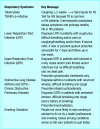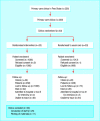Effect of educational outreach to nurses on tuberculosis case detection and primary care of respiratory illness: pragmatic cluster randomised controlled trial
- PMID: 16195293
- PMCID: PMC1239979
- DOI: 10.1136/bmj.331.7519.750
Effect of educational outreach to nurses on tuberculosis case detection and primary care of respiratory illness: pragmatic cluster randomised controlled trial
Erratum in
- BMJ. 2005 Nov 12;331(7525):1120. Myers, Pat [corrected to Mayers, Pat]
Abstract
Objectives: To develop and implement an educational outreach programme for the integrated case management of priority respiratory diseases (practical approach to lung health in South Africa; PALSA) and to evaluate its effects on respiratory care and detection of tuberculosis among adults attending primary care clinics.
Design: Pragmatic cluster randomised controlled trial, with clinics as the unit of randomisation.
Setting: 40 primary care clinics, staffed by nurse practitioners, in the Free State province, South Africa.
Participants: 1999 patients aged 15 or over with cough or difficult breathing (1000 in intervention clinics, 999 in control clinics).
Intervention: Between two and six educational outreach sessions delivered to nurse practitioners by usual trainers from the health department. The emphasis was on key messages drawn from the customised clinical practice guideline for the outreach programme, with illustrative support materials.
Main outcome measures: Sputum screening for tuberculosis, tuberculosis case detection, inhaled corticosteroid prescriptions for obstructive lung disease, and antibiotic prescriptions for respiratory tract infections.
Results: All clinics and almost all patients (92.8%, 1856/1999) completed the trial. Although sputum testing for tuberculosis was similar between the groups (22.6% in outreach group v 19.3% in control group; odds ratio 1.22, 95% confidence interval 0.83 to 1.80), the case detection of tuberculosis was higher in the outreach group (6.4% v 3.8%; 1.72, 1.04 to 2.85). Prescriptions for inhaled corticosteroids were also higher (13.7% v 7.7%; 1.90, 1.14 to 3.18) but the number of antibiotic prescriptions was similar (39.7% v 39.4%; 1.01, 0.74 to 1.38).
Conclusions: Combining educational outreach with integrated case management provides a promising model for improving quality of care and control of priority respiratory diseases, without extra staff, in resource poor settings.
Trial registration: Current controlled trials ISRCTN13438073.
Figures
Comment in
-
Educational outreach visits to primary care nurses improved tuberculosis detection and treatment of obstructive lung disease.Evid Based Nurs. 2006 Apr;9(2):58. doi: 10.1136/ebn.9.2.58. Evid Based Nurs. 2006. PMID: 16622935 No abstract available.
References
-
- Frieden TR, Sterling TR, Munsiff S, Watt CJ, Dye C. Tuberculosis. Lancet 2003;362: 887-99. - PubMed
-
- Sharma DC. Tuberculosis control goals unlikely to be met by 2005. Lancet 2004;363: 1122. - PubMed
-
- Corbett EL, Watt CJ, Walker N, Maher D, Williams BG, Raviglione MC, et al. The growing burden of tuberculosis—global trends and interactions with the HIV epidemic. Arch Intern Med 2003;163: 1009-21. - PubMed
-
- World Health Organization. Global tuberculosis control: surveillance, planning, financing. Geneva: WHO, 2004.
-
- Dye C, Watt CJ, Bleed DM, Williams BG. What is the limit to case detection under the DOTS strategy for tuberculosis control? Tuberculosis 2003;83: 35-43. - PubMed
Publication types
MeSH terms
Substances
Associated data
LinkOut - more resources
Full Text Sources


